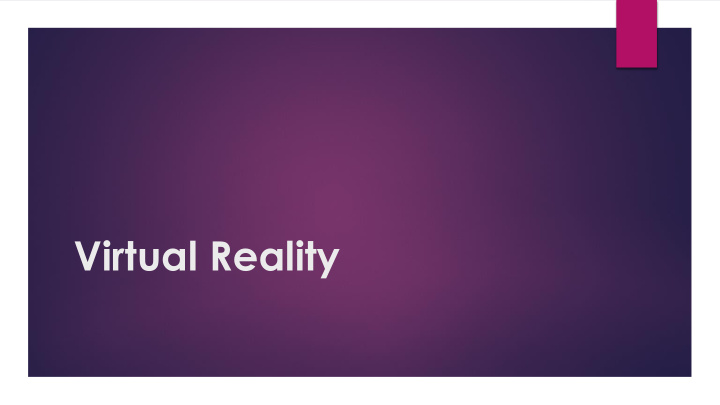



Virtual Reality
Plan Brief talk about Virtual Reality (VR) In pairs, construct VR cardboard goggles (Dodocase) Instructions in print and video Each pair will try out Oculus Rift/Leap Motion to experience VR Each pair can will try out the VR cardboard goggles with a smart phone Compare the two VR experiences
What is virtual reality? also known as immersive multimedia , virtual environment , artificial reality uses computer technology to create a simulated, three-dimensional world that a user can manipulate and explore while feeling as if they are in that world can recreate sensory experiences, which include virtual taste, sight, smell, sound, and touch.
How does it work? a user experiences immersion , or the feeling of being inside and a part of a world a person is also able to interact with his environment in meaningful ways an effective VR experience causes you to become unaware of your real surroundings and focus on your existence inside the virtual environment
Who uses VR technology?
Who uses VR technology? Gaming industry Architecture Car designers Military – simulations (flight) Space program Medicine – training, education, surgery
Brain Surgery http://video.foxnews.com/v/3418901280001
VR on a smart phone/device Two adjustable lenses which project an image of the virtual scene into each eye Using it, you experience a stereoscopic view that spans most of the visual field Combined with the motion sensors of the device this creates a fast and responsive VR experience
Stereoscopy – what is it? also called stereoscopics or 3D imaging a technique for creating or enhancing the illusion of depth in an image by means of stereopsis Stereopsis - perception of depth and 3- dimensional structure obtained on the basis of visual information deriving from binocular vision (two eyes)
http://gamasutra.com/blogs/NickWhiting/20130611/194007/Integrating_the_Oculus_Rift_into_Unreal_ Engine_4.php
Motion Sensors Head orientation and location need to be tracked and used to calculate what to display to the eyes The built-in sensors can determine the orientation of a SmartPhone and hence your head Gyroscope Magnetic compass Gravity sensor (accelerometer)
VR Sickness – What is it? Virtual reality sickness (also known as cybersickness) occurs when exposure to a virtual environment causes symptoms that are similar to motion sickness symptoms. The most common symptoms are general discomfort, headache, stomach awareness, nausea, vomiting, pallor, sweating, fatigue, drowsiness, disorientation, and apathy
VR Sickness – Why does it happen? sickness occurs when the sensory inputs associated with self- motion are in disagreement with one another the refresh rate is slower than what the brain processes, it causes a discord between the processing rate and the refresh rate, which causes the user to perceive “glitches” on the screen when onscreen graphics do not keep the pace with the users’ head movements, it can trigger a form of motion sickness. there is a disagreement between what the stimuli from the eyes send to the brain and what the stimuli from the inner ear are sending to the brain
Dodocase VR Instructions http://www.dodocase.com/pages/VRkit1
VR apps http://www.dodocase.com/blogs/dodo- blog/15547085-great-vr-apps-for-android-and-ios- iphone
Where to buy cardboard VR goggles http://www.amazon.ca/Virtual-Reality-Beginners- Cardboard-Inspired/dp/1941393101
How do VR googles work? The retina of each eye receives a 2D projection of the 3D world from slightly different perspectives, from which the brain reconstructs a 3D experience with illusion of depth. All stereoscopes provide two 2D images, one for each eye to create a 3D illusion. Normally, what you see depends on in which direction you look. To achieve the same with VR goggles, the head orientation and location needs to be tracked and used to calculate what to display to the eyes. Most modern SmartPhones can do all that: Their display is large enough such that if held horizontally about 5cm from your eyes, the left/right eye can see the left/right half of the display. Since your eyes cannot focus to 5cm, you need to wear ultra-strong (+20 dioptre) "reading" glasses. Special Apps that shows two images side-by-side give 3D experience. The built-in sensors (gyroscope, magnetic compass, gravity sensor) can determine the orientation of the SmartPhone and hence your head. GPS and accelerometers can determine its location. http://www.hutter1.net/puzzles/3dvrglass.htm
How does the Oculus Rift work? Picture a set of ski goggles in which a large cellphone screen replaces the glass. The screen displays two images side by side, one for each eye. A set of lenses is placed on top of the screen, focusing and reshaping the picture for each eye, and creating a stereoscopic 3D image. The goggles have embedded sensors that monitor the wearer's head motions and adjust the image accordingly. The latest version of the Oculus Rift is bolstered by an external positional-tracking accessory, which helps track head movements more accurately. The result is the sensation that you are looking around a 3D world. http://www.tomsguide.com/us/what-is-oculus-rift,news-18026.html
References Virtual Reality How stuff works How dive works Stereoscopy DIY 3D Virtual Reality Goggles Motion Sensors
Recommend
More recommend